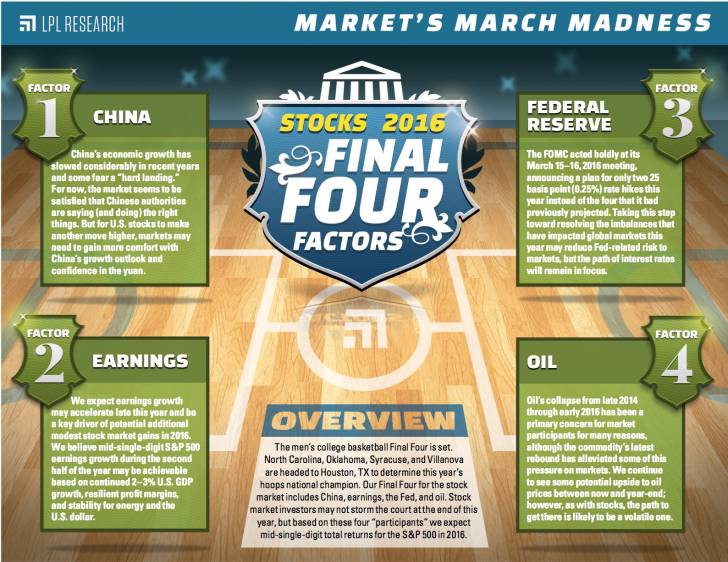Market's March Madness
The NCAA Men’s College Basketball Final Four is set. North Carolina, Oklahoma, Syracuse, and Villanova are headed to Houston, TX to determine this year’s hoops national champion. In that spirit, we share our own Final Four for the stock market this year: China, earnings, the Federal Reserve (Fed), and oil. Stock market investors may not storm the court at the end of this year, but we do continue to expect mid-single-digit total returns for the S&P 500 in 2016[1] based on our assessment of our “Final Four.”
by Burt White, CIO, and Jeffrey Buchbinder, Market Strategist, LPL Financial
The NCAA Men’s College Basketball Final Four is set. North Carolina, Oklahoma, Syracuse, and Villanova are headed to Houston, TX to determine this year’s hoops national champion. In that spirit, we share our own Final Four for the stock market this year: China, earnings, the Federal Reserve (Fed), and oil. Stock market investors may not storm the court at the end of this year, but we do continue to expect mid-single-digit total returns for the S&P 500 in 2016[2] based on our assessment of our “Final Four.”

Semifinalist #1: China
China remains a primary source of concern for markets. Economic growth there has slowed considerably in recent years, from double-digits to a potential sub-6% pace currently, and some fear a “hard landing” and potential growth in the low single-digits. A series of missteps during the summer and fall of 2015 with its currency and equity markets led to a loss of confidence in Chinese policymakers. Markets remain concerned about a potential sharp devaluation of the Chinese yuan that could lead to an Asian currency war, similar to what occurred in the late 1990s. Capital outflows from the country have been significant in recent months, with pending Fed rate hikes adding to the challenge. A lot of work remains to clean up the bad loans in China’s banking system, and property prices remain bubbly in many regions.
More recently, however, Chinese authorities have sounded more rational and appear to be in control. Government officials have sent markets soothing signals that they won’t abruptly devalue the currency and will do whatever it takes to hit China’s (lowered) economic growth target. The Fed has dialed back its projected pace of rate hikes in 2016 (more on that below), which, along with gains over the past several weeks in global equities and commodities, has taken some pressure off Chinese capital markets.
So for now, the market seems to be satisfied that Chinese authorities are saying (and doing) the right things. But for U.S. stocks to make another move higher, markets may need to gain more comfort with China’s growth outlook and confidence in the yuan.
Semifinalist #2: Earnings
This entrant into our tournament could just as easily have been the U.S. economy. Although the two are closely connected, earnings, not economies, drive stock prices. Not only do companies face a challenging global economic environment, but a strong U.S. dollar and the energy sector downturn continue to weigh on profits. Depending on the source of profit calculations, the current quarter (first quarter of 2016) will mark the fourth or fifth consecutive quarter of flat or falling earnings. Expectations for a return of earnings growth have been pushed into the second half of the year and may not reach the long-term average (approximately 7%) until 2017.
Developments in recent weeks have provided some encouraging signs. Oil has rebounded sharply, gaining roughly 50% since the February 2016 lows, and energy sector estimates may now be at least close to what the industry could achieve. The U.S. dollar has pulled back about 4% from its December 2015 peak, and is up only 2% quarter to date versus the first quarter 2015 average, after rising as much as 15 – 20% year over year throughout 2015. During fourth quarter 2015 earnings conference calls in January and February 2016, there was hardly any talk of recession (see our Weekly Market Commentary, “Corporate Beige Book”). And corporate profit margins for the S&P 500 have remained resilient outside of the energy sector, despite the emergence of some labor cost pressures.
Bottom line, we expect earnings growth may accelerate late this year and be a key driver of potential additional, albeit modest, stock market gains in 2016. We believe mid-single-digit S&P 500 earnings growth during the second half of 2016 is achievable based on continued 2 – 3% U.S. gross domestic product (GDP) growth,[3] resilient profit margins, and stability in energy and currency markets.
Semifinalist #3: Federal Reserve
The Federal Open Market Committee (FOMC) acted boldly at its March 15 – 16, 2016 meeting. Citing “global economic and financial developments of recent months,” the Fed’s policymaking arm said it planned just two 25 basis point (0.25%) rate hikes this year instead of the four that it had previously projected. The Fed also lowered its long-run neutral fed funds rate projection by 0.25% to 3.25%. Those two shifts went a long way toward further resolving the imbalances that wreaked havoc on global markets at the start of 2016. The Fed’s move has helped ease the upward pressure on the U.S. dollar, which has positive implications for earnings, commodity prices (notably oil), and emerging market countries with dollar-denominated debts. Stocks have not moved much since the announcement, but the progress toward resolution may help limit the magnitude of potential market pullbacks when they occur.
As we noted in last week’s Weekly Economic Commentary, “The Fed’s Spring Surprise,” the Fed’s decision to help resolve some of the global imbalances may come at a cost, if financial markets and, perhaps more importantly, U.S. consumers begin to see an unwanted uptick in inflation in the coming months. That possibility warrants monitoring, particularly as oil prices recover. The Fed has perhaps become less of a risk to markets following its latest communication, but we continue to believe its path of interest rates will remain in focus.
Semifinalist #4: Oil
We could have predicted this entrant into our tournament before this year’s college basketball season even started. Oil’s collapse from late 2014 through early 2016 has been a primary concern for market participants for several reasons: the oil and gas industry’s massive capital spending, energy companies’ impact on corporate profits, the risk of energy company defaults, and pressures on emerging market countries reliant on energy exports.
Oil’s latest rebound back to around the $40 level has alleviated some of this pressure on markets. Oil production in the lower 48 United States has dropped by 7% from its mid-2015 peak. The Organization of the Petroleum Exporting Countries (OPEC) agreed, in principle, to a “freeze” in production. These moves, if sustained, may help to reduce the global oil glut, further stabilize oil prices, and perhaps reverse some of the related financial stresses. OPEC has scheduled a meeting for April 2016 to assess the freeze and discuss if an actual cut in production is warranted. We are skeptical that OPEC will have much impact, but we do expect additional U.S. supply to come off the market in the coming months and potentially balance oil supply and demand in the second half of this year.
Bottom line, we continue to see some potential upside to oil prices between now and year-end; however, as with stocks, the path to get there is likely to be a volatile one. More of our thoughts on oil can be found in the Weekly Market Commentary, “Oil, Oil, Everywhere but Not a Drop to Buy?”
Upsets
March Madness has also brought us some shocking upsets — none more shocking than Middle Tennessee State’s upset of popular tourney champ pick Michigan State. In the financial markets, the oil rebound has certainly surprised many who were calling for sustained prices in the $20s — oil is up 7% year to date. Other surprise winners this year include market leadership from the telecom and utilities sectors (which we do not expect to continue), and emerging markets — segments of the market without a lot of fans entering this year. The same could be said for the U.S. dollar, which has been a consensus bullish pick among many strategists but has fallen 3% year to date.
Comebacks
Our basketball analogy wouldn’t be complete without acknowledging the tremendous comeback stocks have made since the February 2016 lows, reminiscent of the tremendous comebacks in the NCAA tournament by Texas A&M against Northern Iowa and Syracuse against Virginia. In fact, should the S&P 500 close out the first quarter in the green, it would be just the second quarter since 1928 to be down more than 10% at one point and close higher (it’s fractionally lower with four trading days left). The stock market’s first quarter comeback is not complete, but it has been historic.
Conclusion
There you have it — our Final Four for the stock market in 2016: China, earnings, the Fed, and oil. Stock market investors may not storm the court at the end of this year, but — with some upsets and comebacks along the way — we expect stocks may deliver modest gains for the year.
We also congratulate the teams battling it out for the Women's NCAA Final Four. Syracuse and Washington have secured spots, with the last two to be decided tonight: Connecticut vs. Texas and Baylor vs. Oregon State.
Read/Download the complete report below:
Weekly Market Commentary 03282016
IMPORTANT DISCLOSURES
The opinions voiced in this material are for general information only and are not intended to provide specific advice or recommendations for any individual. To determine which investment(s) may be appropriate for you, consult your financial advisor prior to investing. All performance referenced is historical and is no guarantee of future results.
The economic forecasts set forth in the presentation may not develop as predicted and there can be no guarantee that strategies promoted will be successful.
Investing in stock includes numerous specific risks including: the fluctuation of dividend, loss of principal, and potential liquidity of the investment in a falling market.
All investing involves risk including loss of principal.
Because of its narrow focus, investing in a single sector, such as energy or manufacturing, will be subject to greater volatility than investing more broadly across many sectors and companies.
Commodity-linked investments may be more volatile and less liquid than the underlying instruments or measures, and their value may be affected by the performance of the overall commodities baskets as well as weather, geopolitical events, and regulatory developments.
INDEX DESCRIPTIONS
The Standard & Poor’s 500 Index is a capitalization-weighted index of 500 stocks designed to measure performance of the broad domestic economy through changes in the aggregate market value of 500 stocks representing all major industries.
[1] Historically since WWII, the average annual gain on stocks has been 7 - 9%. Thus, our forecast is roughly in-line with average stock market growth. We forecast a mid-single digit gain, including dividends, for U.S. stocks in 2016 as measured by the S&P 500. This gain is derived from earnings per share (EPS) for S&P 500 companies assuming mid-to-high-single-digit earnings gains, and a largely stable price-to-earnings ratio. Earnings gains are supported by our expectation of improved global economic growth and stable profit margins in 2016.
[2] Historically since WWII, the average annual gain on stocks has been 7 - 9%. Thus, our forecast is roughly in-line with average stock market growth. We forecast a mid-single digit gain, including dividends, for U.S. stocks in 2016 as measured by the S&P 500. This gain is derived from earnings per share (EPS) for S&P 500 companies assuming mid-to-high-single-digit earnings gains, and a largely stable price-to-earnings ratio. Earnings gains are supported by our expectation of improved global economic growth and stable profit margins in 2016.
[3] Our forecast for GDP growth of between 2.5–3% is based on the historical mid-cycle growth rate of the last 50 years. Economic growth is affected by changes to inputs such as: business and consumer spending, housing, net exports, capital investments, and government spending.













